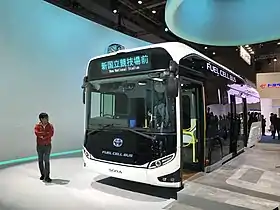Toyota Sora
The Toyota Sora is a transit bus with an electric motor powered by hydrogen fuel cells produced by Toyota, developed in cooperation with Hino Motors. The bus uses components originally developed for the Toyota Mirai, a mid-size fuel cell sedan. The name Sora is an abbreviation of the words Sky, Ocean, River and Air and refers to the water cycle.
| Toyota Sora | |
|---|---|
 | |
| Overview | |
| Manufacturer | Toyota |
| Production | 2018–present |
| Assembly | Japan: Komatsu, Ishikawa (J-Bus)[1] |
| Body and chassis | |
| Class | Transit bus |
| Body style | Single-decker bus |
| Powertrain | |
| Engine | Fuel-cell |
| Electric motor | 2x AC synchronous drive motors 114 kW (153 hp; 155 PS) |
| Transmission | 1-speed |
| Battery | 235 kWh NiMH battery |
| Dimensions | |
| Length | 10,525 mm (414.4 in) |
| Width | 2,490 mm (98.0 in) |
| Height | 3,340 mm (131.5 in) |
The Sora uses two sets of polymer electrolyte fuel cells with an output of 155 hp. The bus is also equipped with a power system, it can be used as an emergency source of electricity, providing external consumers with up to 235 kWh of electricity with a maximum power of 9 kW.
The Sora uses an automatic stopping system, which follows lines on the road and, using automatic steering and braking, stops the bus from 3 to 6 cm (1 to 2 in) from the edge of the stop, and also not more than 10 cm (4 in) in front of or behind the designated stop line. The bus has an environment monitoring system based on eight cameras located inside and outside the vehicle. The system detects pedestrians and cyclists in the vicinity and alerts the driver to their presence using audible and visual signals. The bus is also equipped with the acceleration control function, which, in view of the safety of standing passengers, prevents too rapid acceleration.
The bus is equipped with a radar and a collision warning system, as well as an additional solution to avoid a collision when turning right, which warns the driver about oncoming vehicles or the presence of pedestrians. An additional system alerts the driver when he does not start to brake approaching the red light and additionally displays the time remaining until the signal changes. The Emergency Driving Stop System also allows passengers to stop the vehicle in an emergency, for example when the driver collapses.[2]
The Sora cooperates with the ITS Connect system, which uses communication between vehicles and between vehicles and road infrastructure to improve driving safety, as well as systems supporting bus convoys and ensuring priority at traffic lights (Public Transportation Priority Systems). Toyota buses can exchange information about traffic, pedestrians or changes in lights with other vehicles.
History
The Sora made its debut at the Tokyo Motor Show in 2017.[3] It went on sale in Japan in 2018. More than 100 buses will be in the public transport fleet, mainly in Tokyo, ahead of the 2020 Olympic and Paralympic Games, which will take place in the Japanese capital.[4]
In Europe, the Sora is sold as a chassis fitted with Caetano H2.City Gold bodywork supplied by Portuguese manufacturer Salvador Caetano, who have been a long-time partner for importing Toyota commercial vehicles into Europe. As of 2022, numerous orders for Caetano-bodied Soras have been placed, predominantly in Germany.
References
- "トヨタFCバス、官庁街で試乗会 静かな走り「内緒話聞こえてしまう」" [Test drive event for the Toyota fuel cell bus by district governments. Quiet driving: "I even can hear secret chats"] (in Japanese). Automotive Business Association of Japan. 2018-04-26. Retrieved 2023-06-11.
- "Podczas igrzysk olimpijskich w Tokio pasażerów będą wozić zaawansowane technologiczne wodorowe autobusy" (in Polish). www.komputerswiat.pl. 2019-08-09. Retrieved 2019-08-30.
- "Toyota Unveils FC Bus Concept Sora". newsroom.toyota.co.jp. 2017-10-18. Retrieved 2017-10-27.
- "SORA. NOWATORSKI AUTOBUS TOYOTY" (in Polish). Interia Motoryzacja. 2017-10-20. Retrieved 2017-10-20.